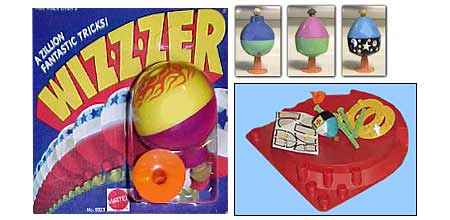Wizzers

Synopsis of Toy
The Spin-Fire, the Mach-1, the Night Winder, the Prowler, the Wedge and the Bonehead. Excepting (maybe) the Bonehead, this reads like a list of maneuvers taught at Top Gun flight school. But simmer down Maverick, you can take off the leather jacket and have a seat, because these are actually the names of Wizzers, the super-spinning gyro-action tops from the late 1960’s.
A spinning top wasn’t a brand-new idea in 1969. The British Museum has glazed composition tops in their Egyptian collection that date back to 1250 BC. Ancient Greek kids spun their fair share of the toys, and the Dreidel dates back to Judea, where it was used as a tool for religious study. More recently, in the 1950’s, tin tops were quite a popular toy with both boys and girls. But that was all before Mattel decided to get into the top business.
The late 1960’s were dominated by the need for speed—hot rods and muscle cars ruled the roads, and even the toy roads found zippier Hot Wheels out-muscling old favorites like Matchbox cars. Mattel responded with the spinning top world’s equivalent of the muscle car. Rather than spinning the top manually between the thumb and forefinger, Wizzers contained—inside their bulbous plastic housing—a gyroscopic motor. A pin jutted out of the Wizzer’s bottom end that was surrounded by a rubber nub. Revving up the Wizzer was easy and intuitive: Roll the rubber tip against a flat surface until the gyroscopic motor gained enough momentum, then release the Wizzer on the end of the metal pin. If spinning the top on the ground wasn’t pleasurable enough, the Wizzer was equally interesting just to hold in your hand. The gyroscopic motor made your hand feel like it was experiencing some heavy g-force action.
In another fine muscle car tradition, Wizzers also incorporated a hefty dose of bad-attitude color and design. Early models came in wild two-tone colors, the top half different from the bottom—and the spiffy packaging contained two holes so that you could peek in and pick your favorite color scheme. Inside each box were a few plastic accessories, like patterned drawing disks and trick ramps, with which you could perfect your spinning stunts.
And then came a Wizzer design onslaught. There was the Canned Wizzer line, made to look like real brand named soda and soup cans (Hawaiian Punch, Planters Peanuts, Campbell’s Soup, etc.). There were Wizzers that came with sticker kits, so that a spinner could soup up his top according to his own personal artistic whimsy—or at least to the degree that combinations of orange flames and stars & stripes allowed. There was the rainbow-making Wizzer, which had a clear plastic top half and a colored disc inside of that, which you could watch spin around. And last, but definitely not least, were the Upsy Downsy Wizzers, in which little yarn-haired Upsy Downsy dolls with names like Furry Hurry and Hairy Hurry actually rode the spinning Wizzers. It figures—creatures with bright hair always get a kick out of vehicles with bright colors.
Wizzers spun into retirement during the 70’s, but were brought back to life in the 80’s by Matchbox and then again by those Yo-Yo folks at Duncan. They’re fondly remembered today in all their gyroscopic glory, both for their retro-cool designs and for the numerous chaotic etchings they made in kitchen linoleum across the nation.
Release History of Toy
1969 - WizzerSub Categories of Toys
hobbiespremiums
other
